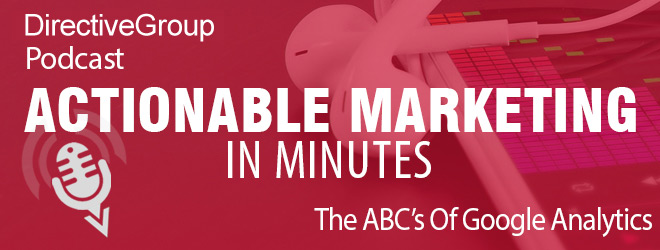In this episode of Actionable Marketing In Minutes we talk about Google Analytics and how you can use it to enhance your marketing campaign.
Use the player below to listen to this episode, or the download link to load it on your device for listening later. You can also find our RSS feed by clicking here, or subscribe by email in the sidebar to the left.
Download our Marketing To Millennials eBook here!
Not able to listen? Why not read the episode transcript below:
Problem:
As we mentioned in our blog How to Create a Remarkable Digital Marketing Program, the definition of the term marketing strategy, which is closely aligned with your business goals, is the marketing objective you are trying to achieve within the next year or other defined time period.
A few marketing programs should emerge from the plan. And, within each program you will have multiple marketing campaigns – each with a beginning and an end.
Finally, within those campaigns, you will devise specific marketing tactics – such as SEO, email and pay-per-click – to reach your campaign objectives, which ultimately culminates in driving the action of bringing visitors to your website to convert. That conversion could be something with minor significance, such as signing up for your newsletter. Or, it can be something more substantial, such as buying something, subscribing for or signing up for a service.
It’s easy to see that your entire marketing venture could easily become a black hole where an unlimited number of budgeted dollars could get lost, never to be seen again, serving no discernable purpose. Because the investment of marketing could become quite costly, it is important to be able to track your visitors’ actions once on your site so you can determine if they are taking the paths to the actions you’d planned for them.
Otherwise, if you are unable to measure your effectiveness and take corrective action, all your efforts could be in vain.
Solution:
There are a good number of analytics tools to track your visitors but Google Analytics (GA) is without a doubt the most popular. Currently, almost 30-million websites use this valuable tool. There are quite a few reasons for that. But, mostly because this powerful application has a nice, clean user interface and it is free – if you opt for the standard version.
Though GA has some pretty advanced features, they aren’t that hard to figure out on a superficial level and if used correctly, can give you invaluable data that will show you the success of your marketing efforts.
When you locate your dashboard, you will see some descriptive graphs that present how many visitors come to your site. And, yes, we do want to see them come… as a starting point. But, as I mentioned earlier, our main goal is not only to get them to come but to get them to follow the sales funnel you’ve developed. To get them to convert.
1. To increase the conversion rate, you will want to analyze the path of existing conversions to determine the story behind them. That will give you a better understanding as to the ‘why’. Once you know that, you can replicate the path the user took to ensure it happens again – regularly.
GA refers to the specific actions users take to convert as ‘goals.’ That’s what you want to know. And, in GA, you can create up to 20 goals to track. You can also add a monetary value to each goal in order to get a quick estimate of projected income over a specific period of time.
2. The definition of a visitor click in GA is an ‘event.’ Events are an easy way to determine where visitors are clicking, which tells you what they find interesting.
3. GA’s ‘Average Time on a Page’ report tells you how long visitors stay on each page. To me, this is one of GA’s most important reports.
When you see a certain page does better than another, you can hypothesize what other related topics or formats could be created that could generate the same type of interest. You can also ask yourself what part of the sales funnel they’re in when they’re drawn to a certain type of content.
4. One of the most power tools in GA is its ability to segment your visitors. This helps you home in with more precision to targeted groups.
Benefits:
I’ve briefly touched on only 4 of the many GA tools you can use to ensure better success with your marketing efforts. After all, no one has the resources – either money or time – to waste on programs, campaigns or tactics that don’t work.
Try these and look for more. They’re not as intimidating to set up as you may have thought. And the benefits are huge.
We hope you’ve found this information helpful. Please connect with us on Twitter @DirectiveGroup or on LinkedIn. Let us know what you think and what you’d like to hear about next. And if you like our podcasts please share with your networks using hashtag #actionablemarketing.
Join us for a future episode as we discuss Best Tips for Increasing Social Media Shares.
Podcast: Play in new window | Download (Duration: 8:36 — ) | Embed
